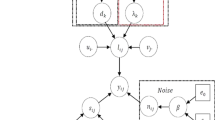Abstract
Feature extraction from two-dimensional or higher-order data, such as face images and surveillance videos, have recently been an active research area. There have been several 2D or higher-order PCA-style dimensionality reduction algorithms, but they mostly lack probabilistic interpretations and are difficult to apply with, e.g., incomplete data. It is also hard to extend these algorithms for applications where a certain region of the data point needs special focus in the dimensionality reduction process (e.g., the facial region in a face image). In this paper we propose a probabilistic dimensionality reduction framework for 2D and higher-order data. It specifies a particular generative process for this type of data, and leads to better understanding of some 2D and higher-order PCA-style algorithms. In particular, we show it actually takes several existing algorithms as its (non-probabilistic) special cases. We develop efficient iterative learning algorithms within this framework and study the theoretical properties of the stationary points. The model can be easily extended to handle special regions in the high-order data. Empirical studies on several benchmark data and real-world cardiac ultrasound images demonstrate the strength of this framework.
Similar content being viewed by others
Explore related subjects
Discover the latest articles and news from researchers in related subjects, suggested using machine learning.References
Bartholomew D, Knott M (1999) Latent variable models and factor analysis. Oxford University Press, New York
Chu W, Ghahramani Z (2009) Probabilistic models for incomplete multi-dimensional arrays. In: Proceedings of the international conference on artificial intelligence and statistics (AISTATS-12)
Ding C, Ye J (2005) 2-Dimensional singular value decomosition for 2D maps and images. In: SDM
Gupta AK, Nagar DK (1999) Matrix variate distributions. Chapman and Hall/CRC, Boca Raton, FL
Inoue K, Urahama K (2006) Equivalence of non-iterative algorithms for simultaneous low rank approximations of matrices. In: CVPR, pp 154–159
Jolliffe IT (2002) Principal component analysis. Springer Verlag, New York
Jordan MI, Ghahramani Z, Jaakkola T, Saul LK (1999) An introduction to variational methods for graphical models. Mach Learn 37(2): 183–233
Kolda TG (2001) Orthogonal tensor decompositions. SIAM J Matrix Anal Appl 23(1): 243–255
Kolda TG, Bader BW (2007) Tensor decompositions and applications. Technical Report SAND2007-6702. Sandia National Laboratories
Lathauwer LD, Moor BD, Vandewalle J (2000) On the best rank-1 and rank-(r1,r2,. . .,rn) approximation of higher-order tensors. SIAM J Matrix Anal Appl 21(4): 1324–1342
Lee DD, Seung HS (1999) Learning the parts of objects with nonnegative matrix factorization. Nature 401: 788–791
Lu H, Plataniotis KN, Venetsanopoulos AN (2006) Multilinear principal component analysis of tensor objects for recognition. In: Proceedings of the 18th international conference on pattern recognition, pp 776–779
Lu H, Plataniotis KN, Venetsanopoulos AN (2008) MPCA: multilinear principal component analysis of tensor objects. IEEE Trans Neural Netw 19(1): 18–39
Roweis S, Ghahramani Z (1999) A unifying review of linear gaussian models. Neural Comput 11: 305–345
Shashua A, Levin A (2001) Linear image coding for regression and classification using the tensor-rank principle. In: Proceedings of the international conference on computer vision and pattern recogniton, pp 42–49
Sun J, Tao D, Faloutsos C (2006) Beyond streams and graphs: dynamic tensor analysis. In: KDD, pp 374–383
Tipping ME, Bishop CM (1999a) Mixtures of probabilistic principal component analysers. Neural Comput 11(2):443–482
Tipping ME, Bishop CM (1999b) Probabilistic principal component analysis. J R Stat Soc B 61: 611–622
Vasilescu MAO, Terzopoulos D (2002) Multilinear analysis of image ensembles: Tensorfaces. In: Proceedings of the 7th European conference on computer vision-Part I, pp 447–460
Wang H, Wu Q, Shi L, Yu Y, Ahuja N (2005) Out-of-core tensor approximation of multi-dimensional matrices of visual data. In: SIGGRAPH
Yang J, Zhang D, Frangi AF, Yang J-Y (2004) Two-dimensional pca: a new approach to appearance-based face representation and recognition. IEEE Trans Pattern Anal Mach Intell 26(1): 131–137
Ye J (2005) Generalized low rank approximation of matrices. Mach Learn 61: 167–191
Author information
Authors and Affiliations
Corresponding author
Additional information
Responsible editor: Tao Li.
Rights and permissions
About this article
Cite this article
Yu, S., Bi, J. & Ye, J. Matrix-variate and higher-order probabilistic projections. Data Min Knowl Disc 22, 372–392 (2011). https://doi.org/10.1007/s10618-010-0183-9
Received:
Accepted:
Published:
Issue Date:
DOI: https://doi.org/10.1007/s10618-010-0183-9




